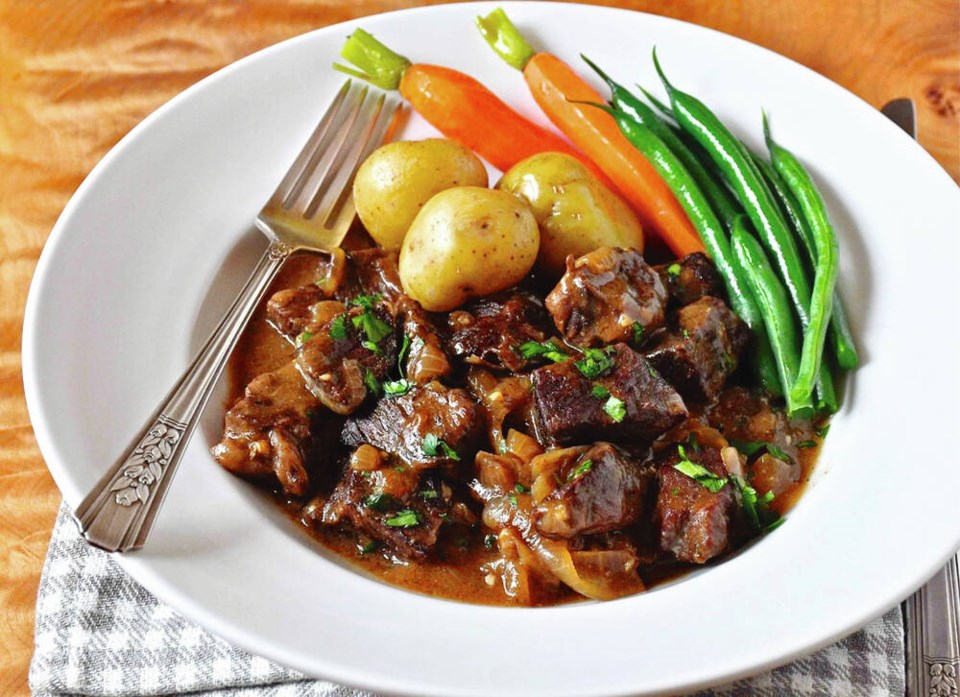If you’re in the mood for a hearty, humble, full-of-flavour, beef stew, carbonnade flamande won’t disappointment. This Flemish-style stew is also called, depending on the source or place your enjoying it, carbonnade à la flamande, beef carbonnade, stoverij, and stoofvlees.
Carbonnade flamande has been made and served in Belgium since at least the 18th century. Some have dubbed it a Belgian answer to France’s beef bourguignon, where the wine in the latter dish is replaced with a liquid Belgian’s are masters at brewing: beer.
Another key ingredient that sets it apart from beef bourguignon is the generous amount of onions used in it. So many that you could call it Flemish-style beef and onion stew.
Like any dish that’s been made for eons, many cooks in Belgium and elsewhere have developed their own particular way of making carbonnade flamande. That explains why when reviewing recipes for it, I could not find two whose ingredients were exactly the same.
The methods were all very similar, though, and involved searing cubes/pieces of beef, sautéing a mound of onions until rich golden, combining the two, and stewing them with flavourings, such as herbs, brown sugar, vinegar and/or mustard, and a liquid or two.
In many recipes that liquid was only beer. In others, including mine, it was beer and beef stock. In most recipes, not surprisingly, given carbonnade flamande’s origins, the beer used was a Belgian one, or a Belgian-style one, such as a malty-tasting, brown – dark or copper coloured – ale, or Trappist/abbey-style beer.
Don’t use a mild-tasting, light coloured beer, or the stew won’t have a rich taste and hue. Or a very hoppy/bitter beer, as it will concentrate in flavour and overwhelm the taste of the ingredients in the stew.
In the past, I’ve had success making carbonnade flamande with Belgian-made Chimay Red Ale, and Chimay Première Trappist Ale, and also different Vancouver Island-made dark ales. But when making today’s recipe, I happened to have some Quebec-made Maudite on hand, purchased at a local liquor store, and used it in the stew.
The maker of it, Unibroue, says Maudite is abbey-style strong red amber ale. It’s described as a complex beer with a scent of spice, orange and malt, followed by caramelized notes, things that added fine flavour to my carbonnade flamande.
In Belgian eateries you’ll often see carbonnade flamande served with frites. I’ve also seen it served over egg noodles or mashed potatoes. It can also be served with boiled potatoes and other vegetables, such as carrot and green beans. The latter is what I did, setting them beside the carbonnade flamande when serving it.
I usually serve the carbonnade flamande right after making it. But you could make it, cool it, refrigerate it, reheat and serve it a day or two later. If you do, you may need to add a little more stock to it, if the stew overly thickens while it’s reheating.
Carbonnade Flamande
Hearty and appealing Flemish-style beef stew rich with onions, beer and sweet and sour flavourings.
Preparation time: 40 minutes
Cooking time: about two hours 35 minutes
Makes: four (generous) to six (more modest) servings
3 1/4 lbs (about 1.5 kg) boneless beef chuck or blade steaks (see Eric options)
• salt and freshly ground black pepper, to taste
4 Tbsp butter (divided)
1 Tbsp olive oil
3 medium yellow onions, halved and cut in 1/4- to 1/2-inch thick slices (about 6 cups)
2 large garlic cloves, minced
1/4 cup all-purpose flour
1 3/4 cups beef stock or broth (divided)
1 1/2 cups Belgian or Belgian-style beer, such as brown or dark ale, or a Trappist or abbey-style beer
2 Tbsp Dijon mustard
2 Tbsp brown sugar
1 Tbsp red wine vinegar or cider vinegar
5 fresh thyme sprigs, tied together with kitchen string (see Eric’s options)
2 bay leaves
2 Tbsp chopped fresh parsley
Cut beef into 1 1/2-inch cubes, discarding any excess fat and sinew you come across.
Set beef in a single layer on a large baking sheet and pat the cubes dry with paper towel. Now season beef with salt and pepper.
Set out a Dutch oven or large ovenproof casserole. Place 2 Tbsp of the butter and the oil in a very large skillet (mine was 12-inches wide) and set over medium-high heat. When butter has melted and is no longer foaming, sear the beef, in three batches, about three minutes on each side. (Don’t crowd the beef when searing it, or it will steam, not sear.) Lift seared beef out of the skillet and set in the Dutch oven (or large ovenproof casserole) as you go along.
When all the beef is seared, set the skillet over medium heat and add the remaining 2 Tbsp butter. When it’s melted, add the onions and cook, stirring occasionally, until rich golden and lightly caramelized, about 15 minutes. While onions cook, preheat oven to 300 F.
When onions are ready, mix in the garlic and flour and cook and stir two minutes more. Slowly mix in 1/2 cup of the stock (or broth). When mixture is very thick, slowly mix in the remaining stock. Now mix in the beer, mustard, sugar, vinegar, thyme sprigs and bay leaves. Bring mixture to a simmer, and then pour over the beef.
Cover and cook the beef in the oven two hours, or until tender and succulent. Remove thyme sprigs and bay leaves from the carbonnade. Taste and season the carbonnade with salt and pepper, if needed. Sprinkle servings of it with chopped parsley.
Eric’s options: If you can’t find chuck or blade steak, good quality, grocery store- or butcher shop-bought, cubed stewing beef, with some marbling of fat in it, will also work in this recipe. If you don’t have fresh thyme sprigs, 1/2 tsp of dried thyme could replace it.
Eric Akis is the author of eight cookbooks. His columns appear in the Life section Wednesday and Sunday.



